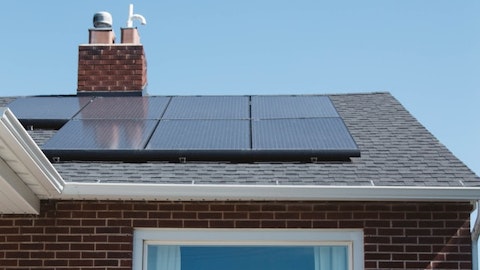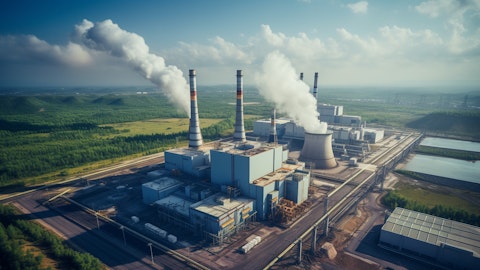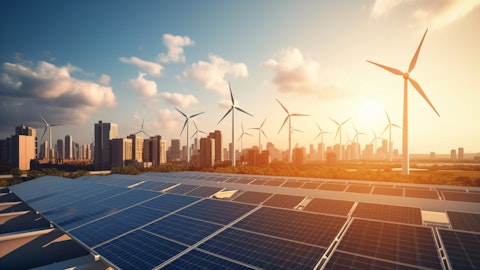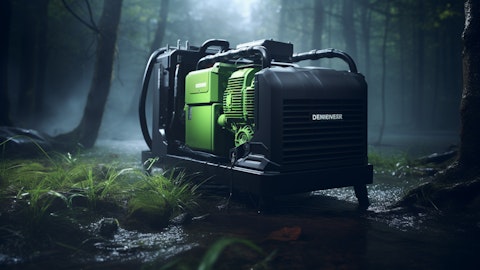Bloom Energy Corporation (NYSE:BE) Q4 2023 Earnings Call Transcript February 15, 2024
Bloom Energy Corporation misses on earnings expectations. Reported EPS is $0.07 EPS, expectations were $0.08. Bloom Energy Corporation isn’t one of the 30 most popular stocks among hedge funds at the end of the third quarter (see the details here).
Operator: Ladies and gentlemen, thank you for standing by. I would like to welcome everyone to the Bloom Energy Q4 2023 Earnings Conference Call. At this time, all lines have been placed on mute to prevent any background noise. After the speakers’ remarks, there will be a question-and-answer session. [Operator Instructions] Thank you. I will now hand the call over to Ed Vallejo, Vice President of Investor Relations. You may begin your conference.
Ed Vallejo: Thank you, and good afternoon, everybody. Thank you for joining us for Bloom Energy’s fourth quarter 2023 earnings conference call. To supplement this conference call, we furnished our fourth quarter 2023 earnings press release with the SEC on Form 8-K and have posted it along with supplemental financial information that we will reference throughout this call to our Investor Relations website. During this conference call, both in our prepared remarks and in answers to your questions, we may make forward-looking statements that represent our expectations regarding future events and our future financial performance. These include statements about the company’s business results, products, new markets, strategy, financial position, liquidity and full year outlook for 2024.
These statements are predictions based upon our expectations, estimates and assumptions. However, as these statements deal with future events, they are subject to numerous known and unknown risks and uncertainties as discussed in detail in our documents filed with the SEC, including our most recently filed Forms 10-K and 10-Q. We assume no obligation to revise any forward-looking statements made on today’s call. During this conference call and in our fourth quarter 2023 earnings press release, we refer to GAAP and non-GAAP financial measures. The non-GAAP financial measures are not prepared in accordance with U.S. Generally Accepted Accounting Principles, and are in addition to, and not a substitute for, or superior to, measures of financial performance prepared in accordance with GAAP.
A reconciliation between the GAAP and non-GAAP financial measures is included in our fourth quarter 2023 earnings press release available on our Investor Relations website. Joining me on the call today are KR Sridhar, Founder, Chairman and Chief Executive Officer; Greg Cameron, our President and Chief Financial Officer; and Aman Joshi, our Chief Commercial Officer. KR will begin with an overview of our business, then Greg will review the operating and financial highlights of the quarter as well as the outlook for 2024. And after our prepared remarks, we will have time to take your questions. I will now turn the call over to KR.
KR Sridhar: Hello, everyone, and thanks for joining us today. Let me start by thanking the Bloom Energy team for relentlessly working on our top objective of 2023, making the company profitable. Together, we achieved profitability by maintaining price discipline, reducing product costs, improving service margins, and reducing operating costs. What a huge milestone for our company. Now, our goal for 2024 is to increase the profitability on a year-over-year basis. In addition to record revenue, significantly improved margins and record annual operating income, we introduced innovative products and offerings, including one just this week. More on that later. Now, let me address the macros in the energy market. Digital transformation, AI, electric vehicles, onshoring of manufacturing and electrification of everything are all increasing demand for electricity at a rate never ever seen before.
All these factors can drive demand for electricity up to 10 times more than the 0.5% average demand growth rate the utility industry is accustomed to for the last four decades. Can a slow-moving industry and the failing grid meet this unprecedented demand challenge? Let’s start with electricity generation. Even breakneck speeds of renewable expansion can at best address a very small fraction of this demand growth. In the last 10 years, all the new renewable capacity installed in the U.S. produces less electrical energy than the deficit created by retired coal and nuclear power plants. New nuclear power will not be online during the next decade in a meaningful way. We have to rely on more natural gas to meet the electricity demand. Once power is generated in faraway locations, it has to be transported to the demand centers by high-voltage transmission lines.
While the National Renewable Energy Laboratory estimates that 90,000 miles of high-voltage transmission lines are needed to meet this growth, 90,000 miles, we have built less than 700 miles in 2022. All this suggests that as a nation, we will imminently face severe and huge power shortage that will last a couple of decades. This situation will be the same in many of the population centers and economic hubs around the world. In the past few months, as I speak to CEOs and business leaders, energy security and power availability are top-of-mind issues for them and their Boards. Most management teams today view the future supply and availability of electricity as a key enterprise risk. Unlike even five years ago, when most of the conversations were around cost of power, today, it is about the opportunity cost and business risk of not having power.
So, how have these macros played out for Bloom Energy on our commercial side? Let me start with data centers, particularly AI data centers. For the last few months, my team and I have been engaged deeply with several leading companies in the AI space, from CEOs all the way to working level technical teams. The sales funnel for this sector alone is massive, not in the megawatts but in the gigawatts. The funnel is composed of several A-list companies with credible growth projections who are told by their utility companies to not rely on them for additional power. They love Bloom’s technology, our rapid deployment capability and the flexibility and optionality of our solution. They are actively working with us on design configurations and implementation scenarios.
In these interactions, our prospective customers tell us that in the absence of reliable and timely power from the grid, the Bloom Energy solution would be their best alternative. Unlike our sales funnels in other sectors in the past that had mostly single-digit megawatt opportunities, this sector offer tens and hundreds of megawatts per opportunity. Most of the opportunities we are pursuing today are for greenfield data centers, in contrast to the past where we offered a cleaner and more reliable power upgrade to an existing data center facility. Greenfield opportunities inherently have elongated sales and implementation cycles. The market in this sector is rapidly evolving, and we will have better visibility on timing as the year progresses.
Over the coming years, I’m very excited about the Bloom solution for data center power and particularly AI data centers, as I see it as the single biggest segment for our growth in the next decade. This opportunity, I highlighted for data centers, carries over to other energy-intensive industries and service operations that require reliable power, such as semiconductor manufacturing, electric charging of bus, van and car fleets, and environmentally-controlled warehouses. We are in various stages of commercial engagement with prospective customers, and I see great potential to convert some of this interest to bookings this coming year. Let me now comment on our innovative product offerings. In the second half of last year, we announced our combined heat and power CHP offering.
This product offering can provide net-zero steam to process industries that are looking to lower their carbon intensity. Alternatively, using this team to create net-zero cooling will be a huge economic and environmental benefit to data centers. We are also seeing a strong interest for our CHP offering in Europe. Earlier this week, we announced the Be Flexible offering. This offering has taken our base load solution offering and transformed it to meet a customer’s varying load. For utilities that need reserve power or for data centers whose power usage varies, the Be Flexible offering provides up to 50% cost savings, 50% carbon reduction at reduced load, and more than 5 times faster power ramp than legacy solutions such as diesel generators and gas turbines.
My team is working with several power companies to use the Be Flexible solution in front of the meter. On the international side, let me take a moment to talk about Korea. Five years ago, we started in Korea with our partners SK ecoplant and SK D&D. We had a shared sense of purpose and goals. We knew that together, we could grow and build a great business in Korea. In the last five years, Bloom has sold over $4 billion of product and service to the Korean market and established Bloom SK as the market leader in fuel cell power generation. We are positioning ourselves to sell over $4 billion of product and service in the coming four years. We are engaged as partners in the demonstration and deployment of hydrogen-based energy servers and hydrogen electrolyzers in Korea.
They are also partnering with us to open up new markets in other countries. In 2023, we had to hit a pause in the deployments to adapt to the new policy and procurement rules that the Korean government enforced in the middle of the year. While that created a lowering of our sales to Korea in second half of 2023 and a slow start in first half of 2024, they are back on track, and we expect a strong business in Korea in the second half of 2024 and in the future. For us, Korea is a model and global leader of energy policy progress and commercial adoption. We are bullish about our future in the Korea market. We hope to replicate it in other markets around the world. Outside of Korea, under Tim Schweikert’s leadership, we have opened five international markets and have our pilot programs going.
He and his team are building a strong pipeline in those countries and confident of opening at least two new global markets. Based on the quality and quantity of the pipeline, we expect our international market to have a strong bookings growth in 2024. At the core of everything we do is our people. We are constantly working to both develop our existing talent and upgrade by adding new talent. Just last week, our CTO, Dr. Ravi Prasher, was elected to the prestigious National Academy of Engineering. It’s a huge honor and well-deserved recognition. Congratulations, Ravi. In January, we were thrilled to welcome Aman Joshi as part of our Bloom leadership team. He joined as our Chief Commercial Officer after a long career in power generation sales.
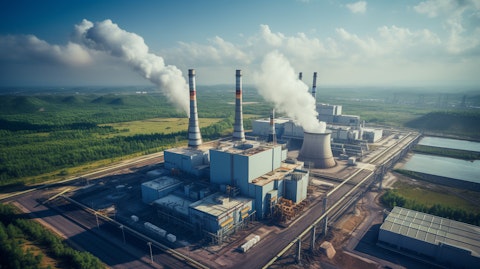
Aman will be responsible to grow our robust sales pipeline with a special focus on converting the opportunities to orders with urgency. Aman, welcome, and over to you for a few remarks.
Aman Joshi: Thank you, KR. It’s great to be speaking with you all today. I just want to say a few words. First, I could not be more excited to join Bloom and be part of all the amazing things happening in this company. The pace of innovation and the confidence in our company’s future is palpable among the employees as I walk the floors. In my prior role, I spent over 20 years at General Electric, most recently focusing on gas turbines and power generation. In the past two years, I sold more than 5 gigawatts of generation capacity. At GE, our focus was doing large-scale projects that were complex and incredibly important. As we advance along the energy transition, it started becoming clear that natural gas and hydrogen are going to play a big role in helping decarbonize the world, both in energy and industrial sectors in the coming decade.
Gas turbines and reciprocating engines are far less efficient when burning 100% hydrogen. In addition, when they combust hydrogen, there are challenges around NOx emissions. Bloom’s solid oxide fuel cell can solve the hydrogen challenge today and generate zero carbon, zero SOx and zero NOx. This is a game changer. I decided to come to Bloom after seeing the product and realizing that it had arrived at an inflection in its ability to function at scale and be a solution for large, complicated, important and timely projects. Bloom is no longer just about potential, but it’s real now and at scale. Bloom’s energy servers can address the most pressing needs of customers across industries, including data centers, utilities and industrial processes.
I’m excited about the pace of innovation here and the flexibility of the product suite. Bloom is a kind of company that can move quickly to develop an application and deliver it to the market. Think about what KR said on CHP and the Be Flexible load-following product. The speed from idea to concept to product at Bloom is remarkable. Its product lead the industry. Just look at the Bloom electrolyzer, which tests have proven is the best and the most efficient in the market. Bloom can solve the big problems that I know exist in the market, and I’m very pleased to now have an opportunity to sell these solutions to the customers that need them. I look forward to speaking with you all further in the Q&A. For now, I’ll turn it over to our CFO, Greg Cameron.
Greg Cameron: Thanks, KR, and welcome, Aman. Let me begin with a few highlights about our strong execution in 2023. In the fourth quarter, we achieved revenue of $357 million, non-GAAP gross margins of 27.4%, non-GAAP operating income of $27.4 million and positive CFOA of $122 million. These quarterly results accumulated into strong performance for the full year 2023. We had record revenue of just over $1.33 billion, up 11% versus last year. Our non-GAAP gross margins were roughly 26%, up 280 basis points versus 2022. We delivered on our milestone of positive non-GAAP operating income of $19 million, up nearly $53 million from the prior year. Our backlog for product and service is now over $12 billion, up 21% versus year-end 2022.
We entered 2024 with over $745 million in total cash. With those as highlights, let me provide some additional context for our performance. In the fourth quarter, we signed a 500-megawatt volume agreement with SK ecoplant. This is a recommitment of 250 megawatts under our 2021 agreement and a commitment for an incremental 250 megawatts. Under the new agreement, the 500 megawatts will be accepted through 2027, providing visibility for nearly $1.5 billion in product revenue over the next four years and $3 billion in service revenue over the next 20 years. The prior agreement was amended to reflect the implementation of the clean hydrogen portfolio standards in Korea. The new agreement adjusted the timing of deliveries, which reduced 2023 revenue by roughly $160 million versus the prior agreement’s 2023 volume commitment.
These deliveries and revenue are incorporated into the $1.5 billion that is expected to be recognized through 2027. As KR shared, global power demand is being driven by electrification, EVs and AI data centers. The world’s current generation, transmission and distribution capacity will be incapable of meeting the additional electricity needs. Our fuel-flexible energy server with enhanced capability of combined heat and power, carbon capture and load following is uniquely positioned to meet the needs today while providing optionality through the energy transition. Clearly, the macro trends are in Bloom’s favor. I’m very encouraged by Aman’s addition to the team. He brings a wealth of experience in the distributed power generation market and rigorous commercial process mindset.
Even after just a few weeks in the role, he’s already making significant impacts. Bloom remains committed to the 2025 targets for product margin, service margin and profitability, as well as our long-term revenue growth rate. As we move through the decade, most of the long-term growth will be driven by our power generation solutions. Our electrolyzer and marine products will contribute as those markets evolve. Our 2023 non-GAAP gross margins of 25.8% improved 280 basis points versus 2022. The margin improvement was driven by a 13% reduction in our unit product costs, offsetting a small reduction from pricing mix, resulting in over a 10% increase in our unit product profit. Clearly, our efforts to lower material costs, coupled with automation and increased power output are driving down product costs.
In every quarter in 2023, we have achieved double-digit cost reductions versus prior year, and we exceeded our 2023 product cost down target. As we move into 2024, we expect to maintain our double-digit cost reductions. As expected, our fourth quarter results in service improved versus prior quarters as revenues grew, performance payments declined and replacement power module costs reduced. We remain committed to our service business achieving 20% non-GAAP gross margins by 2025. We expect our service non-GAAP gross margins to continue to improve and will be a key driver to increasing our overall non-GAAP gross margins in 2024 and beyond. In the fourth quarter, we had positive CFOA of roughly $122 million, building our total cash balance to over $745 million.
In 2023, we made investments in increasing inventory that I would not expect to repeat in 2024. Additionally, I would expect our accounts receivable aging to reduce as we collect from a partner on a large project that has experienced delays. In the fourth quarter, we completed our targeted proactive restructurings. These were focused on managing costs, driving efficiencies and optimizing our performance to ensure that as we grow revenue, our margins can improve and we can generate free cash flow and profitability. As we move into 2024, we’ve consolidated our California stack manufacturing and reduced our operating expenses 19% versus the first half of 2023. A restructuring charge of roughly $7 million was recorded in the fourth quarter that has a pro forma adjustment to our non-GAAP reporting.
As we look forward to 2024, we expect to continue to grow our revenues and expand our margins. Based upon our backlog and pipeline, we are targeting revenue of $1.4 billion to $1.6 billion. We expect additional 200 basis points improvement in our non-GAAP gross margins to about 28%. Based on these targeted revenue and margin performance, I would expect our non-GAAP operating profit to be between $75 million to $100 million. Consistent with prior years, second-half revenue should be greater than first half, driven by timing of Korea shipments and some large acceptances. For the first half, I would expect revenue to be up mid-single digits, with improving profitability versus last year. For the first quarter, the range is a bit broad as we have projects that could be accepted in either the first or second quarter.
First quarter revenue could be flat to down 20% on a tough comparison as the first quarter 2023 was up nearly 40%. Finally, let me spend a few minutes on my departure from Bloom Energy. The last four years has been an amazing professional journey. I want to thank KR, the Board and the entire Bloom family for their support in allowing me to contribute to Bloom’s success. I’m proud of how we’ve worked together to position Bloom for the future. We’ve doubled revenues, improved margins, strengthened our balance sheet, doubled manufacturing capacity and assembled a strong operating team. The world needs Bloom’s solutions, and I’m confident the Bloom team is poised to continue to deliver. This has been a very hard decision for me, but I look forward to enjoying more time closer to my family.
So, while there’s rarely a perfect time for a transition, waiting for one often comes with a personal cost. In the near term, I’ll be focused on ensuring a smooth CFO transition. I am confident in KR and the Board to find the right person to enable Bloom’s continued success. I remain very excited for Bloom’s future. With that, operator, please open the line for questions.
Operator: Thank you. [Operator Instructions] Our first question comes from the line of Andrew Percoco of Morgan Stanley. Please go ahead.
See also Top 20 Most Valuable Blockchain Companies in 2024 and 15 Top Performing European Stocks So Far in 2024.
Q&A Session
Follow Bloom Energy Corp (NYSE:BE)
Follow Bloom Energy Corp (NYSE:BE)
Andrew Percoco: Hi. Thanks so much for taking the question. Greg, first off, best of luck in your next endeavor, and thank you for your partnership over the last few years. It’s been great. And I guess maybe just to start out, on the AI data center theme, I think the idea around power shortages and bottlenecks is definitely gaining some momentum, and you guys have talked about your technology as a key solution for that end market. KR, it sounds like you’re having a lot of conversations with these tech companies that are pursuing AI. But I guess just given some of these power constraints, I would have thought that there would be a faster pace of development on some of these agreements. So, can you maybe just give me a sense for — or give us a sense for where in the process you are in these conversations and maybe some of the remaining items that need to be negotiated or work through to get these across the finish line?
And then, maybe as a separate follow-up, you did allude to some delays in the South Korea market as a driver to downside in your 2023 revenue target. Can you just give us a sense for what’s included in 2024 as it relates to South Korea and how you get comfortable with some of those regulatory changes? Thank you.
KR Sridhar: Andrew, thank you so much. I will speak to the AI data centers, and I’ll have Greg talk to the Korea markets, too, so — and we can both add color to that. So look, if I were to just tell you my last three days, having two days of Board meetings and today of earnings call, in addition to that, if I just look at four meetings I’ve had with large data center players, and this is leadership, C-suite CEO levels. And at Bloom, these meetings are about greenfield data centers. And collectively, these four opportunities that I met would add up in terms of a pipeline interest to more than 0.5 gigawatt. So that’s what we are looking at in terms of what we are being told by these customers. And if you just look at chips, whether it is the big chip companies and what their projections are, if you look at TSMC and the fabs and what their projections are and then multiply that by the amount of power they need, these numbers are very real numbers.
But unlike what we talked about earlier, these are greenfield data centers. So, as we are speaking to these customers, they’re securing the land, they’re securing their financing, they’re securing their offtakes, they’re trying to get their permits. So, it is taking — it’s an elongated cycle. We expect the second half to be a lot more robust than the first half based on everything we’re seeing. And we could have continued to focus at a huge opportunity cost on the other traditional sectors through which we build our pipeline and gotten to a good first half. But we are fiscally disciplined. We are very deliberate on choosing our opportunities, and we see this as an extremely real opportunity with a great focus. And therefore, we are honed in on it, and very optimistic about where our future is going to be in this area.
Greg, do you want to talk about Korea?
Greg Cameron: Yeah, sure. And Andrew, thank you for your kind words. I’ve enjoyed the partnership as well. So, on Korea, as the change came in with the clean hydrogen portfolio standard, it was known all the way back to 2021 that this change was coming, and we didn’t know exactly how it was going to impact the market. But at the time, as partners said, if this does impact timing, then we’re going to have to come back to the table, which we did. I think going forward, looking at where the market is and looking at the bidding process that is there, as we go into this year being ’24 and into next year, I think our partners there have a pretty good understanding of how the market is going to play out. And one of the changes that we made to the agreement that we didn’t have before is we now have quarterly minimums in place.
Before, we had annual minimums and it left us with some uncertainty as we went through the year. We now have quarterly minimums where we can look at to make sure we’re on track for the year. So I think that was a good change. If I look forward in the market out two, three, four, five, six years, that market is going to continue to expand, and the technologies are actually going to come together. So, you won’t have separate swim lanes for fuel cells versus combustion versus other things. That market is going to continue to grow, both for natural gas as it transitions to hydrogen. And I feel very good about Bloom’s products, both on the fuel cell side as well as the electrolyzer to do really well in Korea. So, I’m really encouraged with that market.
I’ve enjoyed my partnership with both ecoplant and D&D very much, and have had the pleasure of spending some time with them over the last few years, and they’ve just been nothing but a great partner. So, we’re really excited about our partnerships there, and we’re excited about the market.
Operator: Thank you. Our next question comes from the line of Manav Gupta of UBS. Please go ahead.
Manav Gupta: Good morning, guys. My quick question here is the 2024 is a range. Help us understand what could push you towards the top end of the range of $1.6 billion in revenue? And also just a quick clarification. You are very capital disciplined. So, with $75 million to $100 million in operating profit, would that imply a minimum cash burn and very small needs, if any, for any external financing, if you could address those issues? Thank you.
Greg Cameron: Yeah. Sure, Manav. It’s Greg. So, listen, when we pulled the plan together for this year, and we looked at it, and this is why a little bit in my script, I talked about being up kind of mid-single digits is where I think the company will be at the midpoint in the year, and that gives us kind of the way we’ve looked at it before, which is the 35% to 40% of our revenue is going to be earned in the first half versus the second half. What’s going to drive us from the lower end of the guide to the higher end of the guide is really on a list of projects that we see both in the U.S., broadly international and in Korea. And my expectation is as we go through the year, we’re going to get more and more clarity around the timing of those projects.
I’m very bullish that we’re going to win our fair share of those projects, and they’re either going to fall in late 2024 or early ’25. So, my expectation as we go through the year, it’s not so much will we have the projects, it will be the timing of those projects. But our full expectation, my full expectation for Bloom is that it will leave 2024 with a bunch of commercial momentum, both in winning deals as well as delivering on systems, and that would drive us to the higher end of the range, I’m hopeful. On the question around cash burn, listen, the metric that I look at, right, is the EBITDA metric. And that says, is the company burning cash on running itself? And we’ve been positive on EBITDA over the last couple of years. So, our CFOA usage has been more around investing in inventories and other things preparing for the growth in those systems.
And I don’t expect to change the view on the inventory levels year-over-year, where we grew them significantly from ’22 to ’23. I would not expect a similar level of growth next year. It was really a way to make sure that we had the business position going forward. If that was the case, that would say you have more opportunity to generate cash in that CFOA bucket than not because you’re not investing in the working capital. As I think about the capital needs for the company, one thing that’s going to be out there that we’re going to need to think about is the 2025 $220 million convert will come current in August. It’s not coming due until August of 2025. But that will be something that the company can be opportunistic around when it chooses to address that.
And with our cash balances and that value of $220 million, we could easily pay that off if we chose. So, I think the company has a lot of options on when and how it addresses those capital needs.
Operator: Thank you. Our next question comes from the line of Dushyant Ailani of Jefferies. Please go ahead.
Dushyant Ailani: Thank you for taking my questions. I wanted to quickly just talk about thoughts on electrolyzer sales going into 2025. I know that you guys mentioned you’re optimistic on that. But I think just given some delays in FIDs in LSB, I just wanted to get your thoughts there.
KR Sridhar: So, this is KR, and I’ll have Greg add some additional comments to that. Look, we have shown ’26 and beyond as there’s going to be meaningful electrolyzer revenue. We think that’s still a possibility. Let me walk you through the few things that we’re looking at right now. As we have told you, we have publicly mentioned in four of the seven hubs, we’re working with some other hubs too, but let’s just talk about the four hubs. These projects are in the pre-FEED engineering right now as we speak, and Bloom is supporting those projects as an OEM. But as you very well know, winning the money for the hub on an 80-20 rule is the 20 side. The 80% of whether these go to FEED and beyond is going to depend on the regulations that come on the production tax credit from the DOE.
That’s what’s going to drive it. So, as we sit here, we are supporting those. But the delays in the PTC is going to delay those implementations as we see it. But we are ready, able and willing to support those things, number one. If you look outside of the U.S. right now, we are in pre-FEED studies in multiple geographies, including Europe, Middle East and Australia, and we are like working on those. And if you look at our project of demonstrating with a nuclear power plant with Xcel Prairie Island, we have already shipped our unit. Now, it’s with the customer who is going to integrate it and start running it. If you look at our INL project with Idaho National Lab, they can’t stop saying enough good things about us. That unit we shipped out there is working extremely well, not just performing but exceeding expectations.
So that’s a summary of our electrolyzer program.
Greg Cameron: Yeah. I think here’s what I’d add is, in addition to that, right, our technology is the most efficient on the market today, and we have over 2 gigawatts of capacity. What you get with Bloom is optionality. So, we see in the near term, and we’ve always talked about this with our long-term growth rates, the majority of the short-term growth is going to be driven by our core power generation projects — product. Now, what’s great about that is we are building out all of the manufacturing capacity, the supply chain, the automation, driving down the cost around our stacks and columns, and it’s the same product, whether we put it in as a fuel cell or as an electrolyzer. So, we are learning every day on how to drive that cost curve down, and we’re not waiting for that.
As well as every day, we get 1 billion data points coming in and how those stacks and columns are performing in the field. So, while we wait for the market to evolve, and it will evolve, and when it does, we think we have a great product that’s going to have really high efficiencies, and we will be ready to manufacture it for our customers. But in the meantime, with Bloom, what you get, it’s amazing optionality because we’re not waiting on that market to develop. We still have a company last year that generated $1.33 billion in revenue as it built out the business.
Operator: Thank you. Our next question comes from the line of Pavel Molchanov of Raymond James. Please go ahead.
